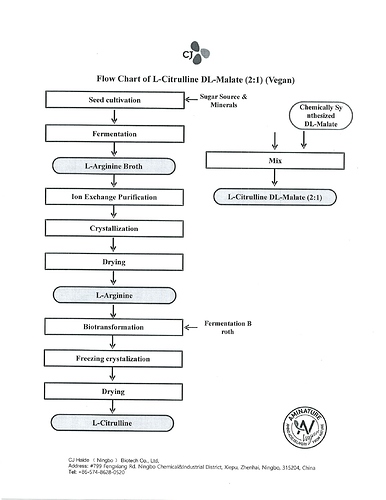For those of you who are citrulline malate fans, get ready for the answer that you don’t want to hear. Unfortunately, the industry has hidden from you the fact that real citrulline malate hasn’t been commercially manufactured for years, or at least I have not been able to find any. And with my resources stemming from 18 years of manufacturing experience, if it’s out there, I would have found it.
Authentic citrulline malate (CM) is produced by chemically bonding free form l-citrulline to DL-malic acid, so the result is an entirely different compound with unique properties. The common CM on the market today is not chemically reacted; it’s just citrulline, and malic acid dry blended in a vat – no catalyst is added to form the chemical reaction required to bond the citrulline to the malic acid – it’s just a cheap blend – two separate chemicals mixed in a tub. It’s like me selling you a tub filled with arginine and glycine and claiming its creatine… it’s not. This is the same scam manufacturers pulled 15 years ago when I exposed them for cheating with amino-AKGs. It’s just more industry bullshit.
The standard citrulline Malate used in the sports industry is the blended format. That means when the label claims 6g of CM 2:1, you’re actually getting 4g free form L-citrulline mixed with 2 grams of malic acid as compared to label that claims 6g citrulline where you are getting 6g. Could some brands be using reacted CM, I guess it’s possible.
Here is a copy of a manufacturing flowchart for L-Citrulline DL-Malate from one of the larger manufacturers. Do you notice anything peculiar about it? The left column shows the manufacturing process for L-citrulline, the right column shows the manufacturing process for CM - which as you can see is limited to one word: MIX. I’ve been speaking about this for years now. It’s another case of the industry turning a blind eye to a scam for so long that it has become standard industry practice.
The earlier CM studies dating back to 2010 were done using chemically reacted CM, therefore, they cannot be applied to today’s blended CM because they are different chemicals. I get attacked all the time by people claiming that I switched from CM to citrulline because it’s cheaper. Bullshit, fermented citrulline is much more expensive, and I switched because manufacturers stopped producing CM.
Now if you are getting benefit from CM, there is a good reason: both ingredients work wonders on their own. Citrulline bypasses the liver and gets converted to arginine which increases nitric oxide. Malic acid is a Krebs cycle intermediary (as is citric acid) used in energy production and countering lactic acid buildup. So both are excellent for improving training capacity. What’s interesting about malic acid is that’s it is commonly used as a flavor enhancer along with citric acid. They are both used in almost every pre-workout, intra and BCAA product on the market — there is GOOD news though - 2 ingredients most commonly listed in the fine print as inactive, are actually active and very beneficial.
Let me add some fire to this discussion: reacted CM is a salt that will break down into citrulline and malic acid as soon as you mix it with water. Huh?? that’s right, so you are right back where you started had you used the blended version.
Regardless of whether the citrulline malate is the reacted ionic salt or just the blend, you might have used it and felt some benefit and you should as long as it is sufficiently dosed and high quality. This is because both ingredients work on their own. citrulline bypasses the liver and gets converted to arginine which increases nitric oxide. Malic acid is a Krebs cycle intermediary used in energy production and countering lactic acid buildup. The real question is how much do you need of each to get the corresponding benefits. There is research on citrulline but not much on supplementing with malic acid to replenish depleted levels as a Krebs cycle intermediary. I don’t think we can infer through the research on CM that the malic acid was the bioactive component since we can’t determine if the results came from the citrulline, the malic acid or a synergistic blend of the two.
